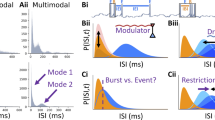Abstract
The pyloric pattern approximately maintains phase over a three- tofivefold frequency range when the pattern is defined by the pacemakerburst beginning. However, in this reference frame certain patternelements maintain phase better than others, which suggestsphase-maintaining subgroups might exist. Reanalysis of these data inreference frames defined by each element shows the pattern containstwo groups of pattern elements within which phase is well maintainedbut between which maintenance is relatively poor. A third elementshows intermediate maintenance with each group. If ventriculardilator neuron burst beginning (VDB) is chosen as pattern beginning,all members of one group occur early in the pattern, all members ofthe other occur late in the pattern, and the intermediate elementoccurs between the groups. Thus, at least for phase maintenance, VDBis a “natural” pyloric pattern beginning. These results suggestfull description of complex patterns is best achieved by analysis inmany reference frames.
Similar content being viewed by others
References
DiCaprio RA, Jordan G, Hampton T (1997) Maintenance of motor pattern phase relationships in the ventilatory system of the crab. J. Exp. Biol.200:963–974.
Eisen JS, Marder E (1982) Mechanisms underlying pattern generation in lobster stomatogastric ganglion as determined by selective inactivation of identified neurons. III. Synaptic connections of electrically coupled pyloric neurons. J. Neurophysiol. 48:1392–1415.
Hartline DK (1979) Pattern generation in the lobster (Panulirus) stomatogastric ganglion. II. Pyloric network simulation. Biol. Cybern. 33:223–236.
Hooper SL (1994) Control of follower neuron phase in the pyloric network (abstract). Soc. Neurosci. Abstr.20:1414.
Hooper SL (1995) Degree of phase maintenance depends on which neuron is used to define pyloric period (Abstract). Soc. Neurosci. Abstr.21:151.
Hooper SL (1996) Phase maintenance in the pyloric pattern of the lobster (Panulirus interruptus) stomatogastric ganglion. J. Comput. Neurosci.4:191–205.
Hooper SL, Marder E (1987) Modulation of the lobster pyloric rhythm by the peptide, proctolin. J. Neurosci.7:2097–2112.
Hooper SL, Moulins M (1990) Cellular and synaptic mechanisms responsible for a long-lasting restructuring of the lobster pyloric network. J. Neurophysiol.64:1574–1589.
Kepler TB, Marder E, Abbott LF (1990) The effect of electrical coupling on the frequency of model neuronal oscillations. Science 248:83–85.
Marder E (1984) Roles for electrical coupling in neural circuits as revealed by selective neuronal deletions. J. Exp. Biol.112:147–168.
Marder E, Abbott LF, Kepler TB, Hooper SL (1993) Physiological insights from cellular and network models of the stomatogastric nervous systems of lobsters and crabs. Am. Zool.33:29–39.
Miller JP, Selverston AI (1982a) Mechanisms underlying pattern generation in lobster stomatogastric ganglion as determined by selective inactivation of identified neurons. II. Oscillatory properties of pyloric neurons. J. Neurophysiol.48:1378–1391.
Miller JP, Selverston AI (1982b) Mechanisms underlying pattern generation in lobster stomatogastric ganglion as determined by selective inactivation of identified neurons. IV. Network properties of pyloric system. J. Neurophysiol.48:1416–1432.
Russell DF, Hartline DK (1982) Slow active potentials and bursting motor patterns in pyloric network of the lobster, Panulirus interruptus. J. Neurophysiol.48:914–937.
Selverston AI (1977) Neural circuitry underlying oscillatory motor output. J. Physiol. (Paris)73:463–447.
Selverston AI, Russell DF, Miller JP, King DG (1976) The stomatogastric nervous system: Structure and function of a small neural network. Prog. Neurobiol.7:215–290.
Selverston AI, Miller JP, Wadepuhl M (1983a) Cooperative mechanisms for the production of rhythmic movements. SEB Symp. 37:55–87.
Selverston AI, Miller JP, Wadepuhl M (1983b) Local circuits for the generation of rhythmic motor patterns. J. Physiol. (Paris) 78:748–754.
Selverston AI, Moulins M (1985) Oscillatory neural networks. Annu. Rev. Physiol.47:29–48.
Warshaw HS, Hartline DK (1976) Simulation of network activity in stomatogastric ganglion of the spiny lobster, Panulirus. Brain Res. 110:259–272.
Author information
Authors and Affiliations
Rights and permissions
About this article
Cite this article
Hooper, S.L. The Pyloric Pattern of the Lobster (Panulirus interruptus) Stomatogastric Ganglion Comprises Two Phase-Maintaining Subsets. J Comput Neurosci 4, 207–219 (1997). https://doi.org/10.1023/A:1008867702131
Issue Date:
DOI: https://doi.org/10.1023/A:1008867702131




